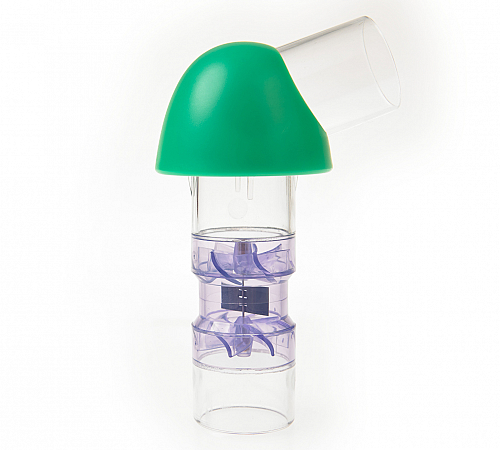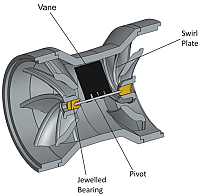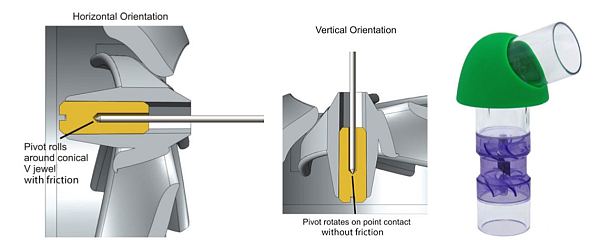New Spirometry Turbine Transducer – Low Flow Problem Solved

The use of turbine technology for spirometers was first described in 19821 and has become popular in general practice.
The turbine transducer consists of two fixed swirl plates at either end of a short tube. Between the swirl plates a low mass vane on a pivot is supported by two jewelled bearings:

As air flows through the turbine a vortex is created by the swirl plates and the vane rotates within the vortex. The rotation of the vane is detected by the interruption of an infra-red beam passing through the turbine. The number and rate of interruptions is proportional to the volume and flow through the turbine respectively.
The number of interruptions per litre depends on the geometry of the swirl plates and therefore the calibration is very stable2 and is also largely independent of air density and altitude3.
A turbine vane will stop rotating when the torque on the vane due to the vortex is balanced by opposing forces of friction in the bearings, torque required to rotate the vane against gravity, and static attraction between the vane and swirl plates. These forces are insignificant at high flows but dominate at very low flows.
It is known that many turbines only respond to flows well in excess of 0.025l/s and therefore fail to comply with international standards4.
The patented5 design of the new SpiroConnect turbine (MedChip Solutions Ltd, Kent, UK) reduces all of the opposing forces that limit the low flow sensitivity of other turbine designs.
1. Friction in the bearings is reduced by orientating the turbine vertically

2. Torque required to lift the vane against gravity is also eliminated as the vane now rotates in a horizontal plane
3. Static attraction between the vane and the segments of the swirl plates has been eliminated by using transparent anti-static plastic for the construction.
All of these innovations have resulted in a turbine performance that now exceeds the low flow sensitivity requirements of all international standards.
SpiroConnect is a PC based spirometer that can be used with a desktop or laptop computer. For more information please visit our dedicated SpiroConnect product page here.
References
1. Pocket-sized device for measuring forced expiratory volume in one second and forced vital capacity. Chowienczyk PJ, Lawson CP. Br Med J (Clin Res Ed). 1982 Jul 3;285(6334):15-7.
2. Long term performance of a handheld spirometer - Asger Dirksen, Flemming Madsen, Ole Find Pedersen, Anne Mette Vedel, Axel Kok-Jensen. Thorax 1996;51:973-976
3. Portable peak flow meters: physical characteristics, influence of temperature, altitude, and humidity - O.F. Pedersen, M.R. Miller, T. Sigsgaard, M. Tidley, R.M. Harding. Eur Respir J, 1994, 7, 991–997 - DOI: 10.1183/09031936.94.07050991
4. Eur Respir J 2005; 26: 319–338. Standardisation of Spirometry.
5. The following patents rights apply to the vertical turbine technology: European Patent Application Number 13724330.9 | GB Patent Number 2500893



